Experienced all-terrain vehicle ZIS-E134 "Layout No. 2"
In the autumn of 1955, the first version of the ZIS-E134 all-terrain vehicle began to be tested. It was a four-wheel drive four-wheel drive vehicle with large-diameter wheels capable of carrying up to 3 tons of cargo and towing an 6-ton trailer. A characteristic feature of “Layout No. XXUMX” was the widest use of ready-made components and assemblies borrowed from serial equipment. At the same time, using existing components, we managed to implement several fundamentally new ideas. During the tests, the prototype was supposed to confirm or disprove the viability of the applied solutions.
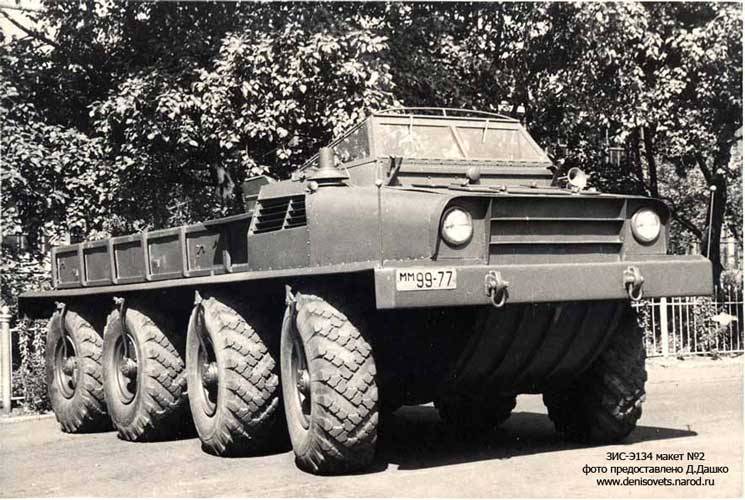
All-terrain vehicle ZIS-E134 "Layout 2" without awnings. Photo Denisovets.ru
During the tests of the ZIS-ЭNNUMX machine, it was found that the proposed power plant and transmission meet the requirements and provide the desired capabilities. At the same time, it was determined that the running gear, showing the required characteristics, proved to be unreasonably difficult. Large tires with relatively low pressure correctly responded to uneven terrain and literally left spring suspension out of work. Due to certain features of the “Layout 134” design, water barriers could only cross the ford.
At the end of the 1955 of the year, having received the first test results of the first prototype, the designers of the SKB ZIS, headed by V.A. Grachev started to develop a new version of a promising vehicle. In the new pilot project was planned to use some of the already tested developments. They were asked to combine with some new ideas. As a result of this, the second version of the ZIS-E134 project should have been significantly different from the first. At the same time, due to the experimental nature of the work, they did not rename the new project and retained the previous name.
In order to distinguish two experimental machines of different appearance, the second prototype was designated as “Layout No. XXUMX”. According to some sources, in the documents of the Ministry of Defense this experienced all-terrain vehicle was listed as ZIS-2E134. The presence of additional symbols while maintaining the common name avoids possible confusion, although it does not exclude it completely. Also, it should not be forgotten that within the framework of the ZIS-E2 project two more prototypes were built, which also differed from the previous technology.
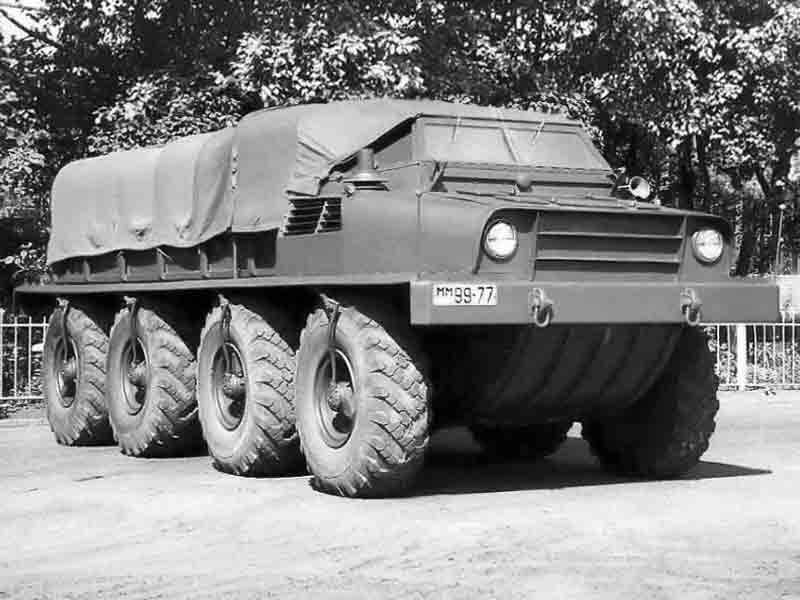
Prototype with awnings. Photo Russoauto.ru
All-terrain vehicle ZIS-E134 “Layout No. 2” was proposed to be made floating, which is why the designers had to refuse to save the mass features of the first prototype. So, instead of the frame structure, you should use a sealed carrying case. According to the results of tests of the first prototype, they decided to abandon the elastic elements in the composition of the suspension. Finally, a certain rearrangement of the internal hull volumes was required. As a result, two prototypes had minimal external and internal similarity.
The first model was built on the basis of a metal frame, but in the new project they decided to use a displacement bearing hull of a special form capable of turning the land-based all-terrain vehicle into an amphibian. An interesting fact is that the hull lines and layout applied in the ZIS-134E2 machine were subsequently used in a number of new projects. This design has proven itself and confirmed its potential.
All the main units of the machine was placed in a large lower part of the body. She had curved lower parts in the front and back. On the sides of them were located the vertical side with the attachment points of the wheels. Used horizontal bottom. From above in front on such case the hood of the average sizes which was distinguished by a non-standard form was established. To protect the engine and the hull from flooding with seawater, the radiator grilles were moved not by the hull sides and shifted back. A metal strip construction appeared on the front sheet that increased the rigidity of the bonnet. At the radiator level there was an open cabin of a simplified design. The entire middle and rear part of the hull formed a large cargo area.
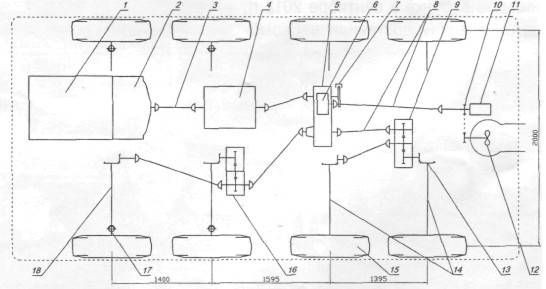
Kinematic scheme of the car: 1 - engine; 2 - torque converter; 3, 8 - cardan transmission; 4 - gearbox; 5 - transfer case; 6 - KOM on the transfer case; 7 - parking brake; 9, 16 - power take-off; 10 - water jet drive chain transmission; 11 - ZIS-151 promo support; 12 - water cannon; 13 - main gear; 14 - rear axle; 15 - wheel; 17 - semi-axle with a knuckle; 18 - front driving axle. Figure Ser-sarajkin.narod2.ru
In front of the body was a gasoline engine ZIS-121А, equipped with an aluminum cylinder head. The engine used developed power up to 120 HP. As on “Layout No. 1”, a three-stage automatic hydraulic transmission, originally developed for the ZIS-155A bus, was connected to the engine. Such a hydraulic transmission / torque converter had to solve several problems at once. She allowed to protect the engine from a stop at excess of loading, several times increased a torque at a start of movement and automatically switched transfers, facilitating work of the driver. The presence of a built-in reverse simplified the “swinging” of the stuck all-terrain vehicle.
Power was transferred from the torque converter to a five-speed gearbox taken from a ZIS-150 truck. This was followed by a two-stage (both gears lowering) transfer case connected to two power take-offs. These three devices were serial and were produced for the armored personnel carriers BTR-152В. From the power take-offs, the cardan shafts moved away from the axial self-locking differentials. During one of the subsequent refinements in the transmission, a power take-off for the feed propulsion unit appeared.
In the updated ZIS-E134 project, the four-axle chassis architecture was retained, but its individual units were reworked. First of all, SKB ZIS refused elastic suspension. “Layout No. XXUMX” showed the possibility of using low pressure tires as a means of depreciation, and therefore on the “Layout No. XXUMX” semi-axles were fixed on the body rigidly. Unlike the previous car, it was decided to install the axis with different gaps. Thus, the centers of the first and second wheels were separated by 1 mm, the second and third - by 2 mm. The third gap has been reduced to 1400 mm.
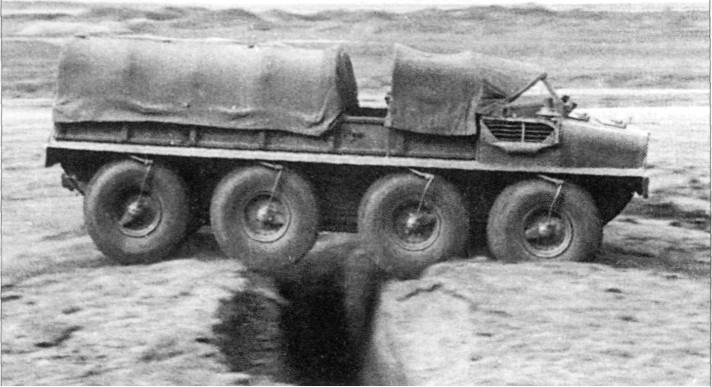
A mockup model moves the trench. Trucksplanet.com Photos
The continuous axles with differentials were borrowed from the armored personnel carrier BTR-152В and slightly modified for some increase in the gauge. Six-layer construction tires were used. The wheels were connected to a centralized pumping system, which allowed to change the pressure from 3,5 kg / sq. Cm to 0,5 kg / sq. Cm. Like its predecessor, the new prototype model received power steering, built on ready-made components. With it, the driver could control the position of the four front wheels. In practice, it was shown that two controlled axles can significantly improve the maneuverability of the machine on any surfaces.
Initially, the designers decided that the amphibian ZIS-E134 "Model No. 2" will float due to the rotation of the wheels. Nevertheless, after the first such tests, it was decided to equip it with a water jet. This product is borrowed from floating tank PT-76. Unlike the latter, which had two water jets, the all-terrain vehicle was equipped with only one such device. For this reason, to control the course, the water cannon had to be supplemented with a rotary cylindrical nozzle that controls the thrust vector.
In case of problems on the track of the landfill, the prototype was equipped with its own winch for self-pulling. The drive of this device was carried out at the expense of a separate cardan shaft, departing from the transmission.
A characteristic feature of the second prototype of the ZIS-ЭНNUMX was an open cabin of a simplified design, borrowed from the experimental amphibian ZIS-134. It was located directly behind the engine compartment and above some transmission devices. Above the hood, a frame was fixed with a windshield, complemented by small side elements. The roof was absent, but in its place there were arcs for the installation of an awning. The driver was located in the left side of the cab. To the right of the control room placed various equipment and the second seat, installed sideways in the direction of travel. The third workplace of the tester was behind the driver. It was suggested to get into the car through the low side of the cabin.
All the middle and rear of the hull were given under the onboard body. It was a relatively long area, fenced with low sides. There were knots for the installation of arcs, on which it was proposed to stretch the awning. For greater convenience, the cabin and body were closed with two separate awnings.
In its dimensions, “Layout No. XXUMX” was similar to the previous “Layout No. XXUMX”. Part of the basic characteristics of the two machines was also on the same level, meeting the requirements of the customer. The length of the second prototype reached 2 m, the width was about 1 m. The height of the tarpaulin arcs approached 6,8 m. The all-terrain vehicle's clearance, determined by the bottom of the new hull, was reduced to 2,2 mm. The rejection of a number of components led to a sharp reduction in the weight of the structure. The curb weight was 2,5 t. The all-terrain vehicle could take on a payload weighing up to 345 kg. At the same time, its total weight reached 6,518 t. The theoretical possibility of towing a trailer was preserved.
The construction of the prototype ZIS-ЭNNXX “Layout No. 134” was completed at the beginning of April 2. Soon the car was taken to the site for running in and determine the main characteristics. It was found that the cardinal processing of the structure did not adversely affect the mobility characteristics. So, the speed of the machine on land reached 1956 km / h. On rough terrain, the maximum speed fell by almost half. The all-terrain vehicle confirmed the possibility of climbing a wall 58 m high or crossing a moat 1 m wide. It could climb the slope of the 1,5 ° steepness and move with a heel to 35 °.
Characteristics on the water when using the wheels were insufficient. The car kept on the water, but the speed of movement left much to be desired. As a result, a small modernization of the layout was carried out, providing for the installation of a jet propulsion unit. Now, having gone down into the water and having turned on the new water cannon, the all-terrain vehicle was developing speed up to 6 km / h
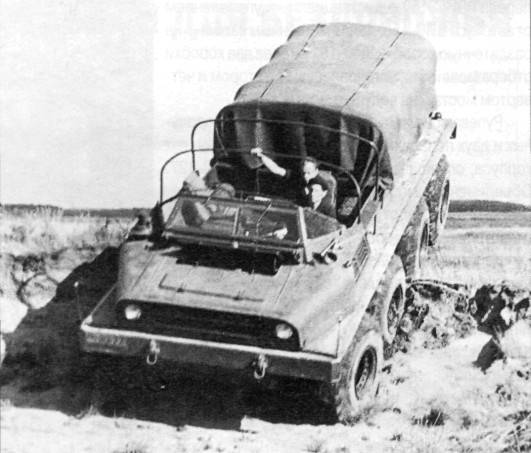
Descent Trucksplanet.com Photos
Within a few months, the specialists of the Plant them. Stalin and the Ministry of Defense conducted tests built "Layout №2" / ZIS-134E2, collecting the necessary data on the work of individual units and the machine as a whole. The car confirmed the calculated characteristics and showed the positive aspects of the applied innovations. In practice, the advantages of an all-terrain vehicle with a displacement hull were demonstrated. Unlike its predecessor, the new mockup could move not only by land or ford.
In August, the 1956 of the year, one of the test machines built by one of the landfills came out. This time the manufacturer and the military department were going to check them in the framework of comparative tests. The information gathered earlier allowed certain assumptions to be made, but new tests were required to confirm preliminary findings. “Layout No. XXUMX” expectedly showed its characteristic features and confirmed the advantages over the older “Layout No. XXUMX”.
After comparative tests, the experienced all-terrain vehicle of the second model returned to the manufacturer, by which time it had received the new name “Zavod im. Likhachev. Developing the ideas underlying the project, the designers of SKB ZIL proposed to rebuild the chassis and significantly refine the transmission. With the help of special brackets, the first and fourth bridges were carried forward and back, respectively, beyond the limits of the original sides, while the gap between the central axes was reduced. Calculations showed that such a layout of the chassis will optimize the load distribution on the ground.
Over the next few months, the rebuilt mockup model No.2 was run-in at the landfill to determine the real advantages of the upgraded chassis. It was found that placing the wheels at different intervals really makes sense and provides some advantages over the original configuration. These findings were taken into account when creating a new special equipment.
According to various sources, the tests of the updated “Layout No. XXUMX” continued until the 2 year. After that, the prototype was sent to the storage area. Information collected during the tests was soon used in the development of new all-terrain vehicles for various purposes. The first model of the technology, which was used in the development of ZIS-1957-134, was the special chassis ZIL-2. A displacement body and a four-axle chassis with a rigid suspension and a special arrangement of bridges passed from the experimental model to it. Subsequently, the ZIL-135 project was developed, and a number of modifications of the machines were used in various fields.
The second project of the ZIS-E134 family was developed with the aim of testing a number of new ideas that could increase the maneuverability of technology and expand its scope. The new hull and rebuilt chassis proved themselves and soon moved into new designs of equipment already intended for use in practice. However, research on the subject of ultra-high cars did not stop. In the same year 1956, prototypes No.0 and No.3, also created in the framework of the ZIS-Э134 project, came to the landfill.
Based on:
http://denisovets.ru/
http://avtohistor.ru/
http://russoauto.ru/
https://trucksplanet.com/
http://strangernn.livejournal.com/
Kochnev E.D. Secret cars of the Soviet Army. - M .: Yauza, Eksmo, 2011.
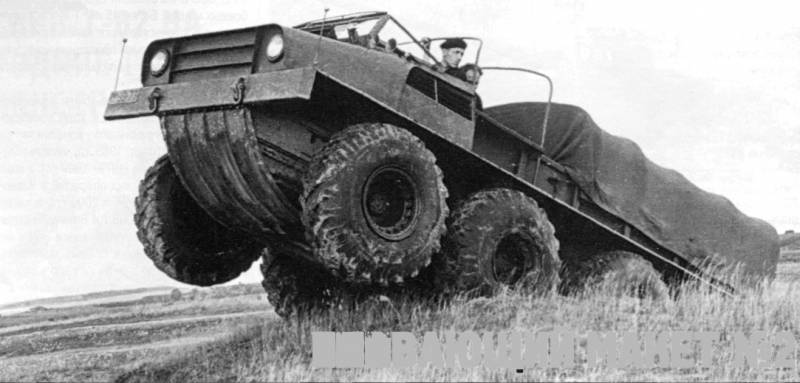
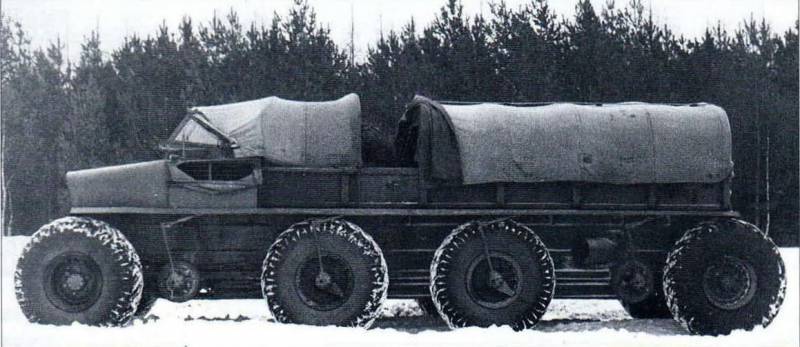
Information